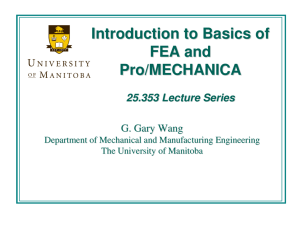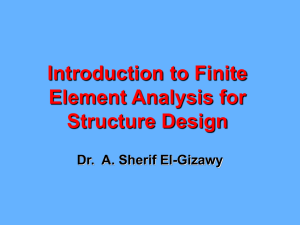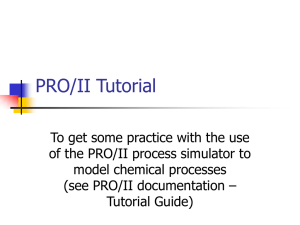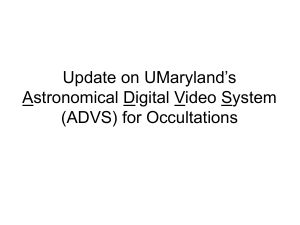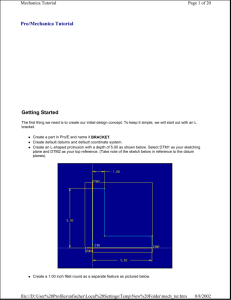What is Pro/Mechanica?
advertisement
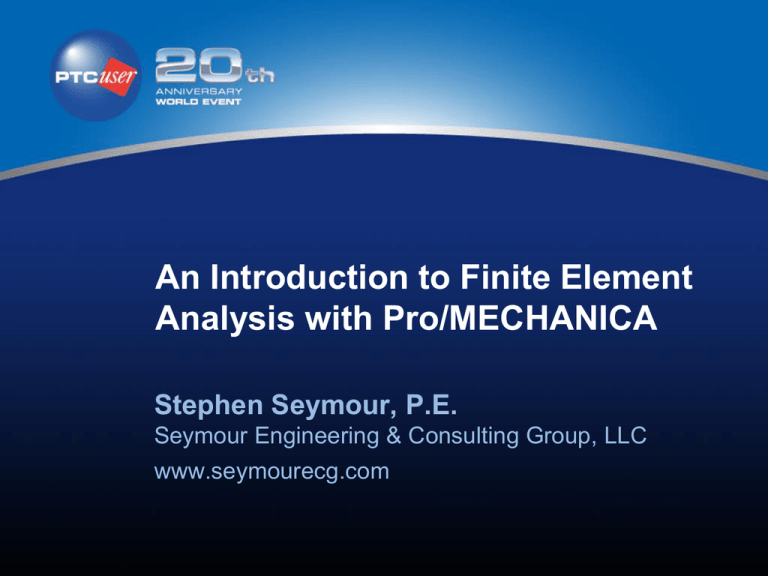
An Introduction to Finite Element Analysis with Pro/MECHANICA Stephen Seymour, P.E. Seymour Engineering & Consulting Group, LLC www.seymourecg.com Presentation Outline • Introduction to Pro/Mechanica • Capabilities and differences • Cantilever beam demo • Materials, loads, and constraints • Element types and meshing • Idealizations, connections, and contact • Analysis definition and convergence • Reviewing results What is Pro/Mechanica? • Pro/Mechanica is general finite element analysis (FEA) software tool that is directly integrated into Pro/Engineer • Pro/Mechanica (also referred to as Simulation) is generally classified as a structural and thermal Computer Aided Engineering (CAE) tool. Pro/Mechanica Capabilities • Static structural stress/strain/disp • Modal, prestressed modal, and mechanical vibration • Buckling • Non-linear contact / large deformation • Fatigue • Hyperelastic materials • Steady state thermal analysis • Transient thermal analysis How Does Pro/Mechanica Differ? • Pro/Mechanica is a linear P-element finite element solver • Most other commercial FEA packages are H-element codes • The difference: convergence method – P: varies element shape functions – H: mesh refinement How Does Pro/Mechanica Differ? • Pro/Mechanica by default is a linear finite element solver with some non-linear capabilities • Automated convergence via element shape function adaptation – Multi-pass adaptive (MPA) – Single pass adaptive (SPA) Analysis Methodology Cantilever Beam Demonstration • Goal: determine the maximum bending stresses Solution Comparison Analytical Solution • Analytical model based on classic beam theory for slender uniform cross section beams Solution Comparison Pro/Mechanica FEA Solution • Pro/Mechanica FEA results indicate maximum bending stress is approximately 6000 psi • Stress varies linearly along length of beam as expected Applying Material Properties Parts • Pro/Mechanica provides a default library of materials • Ability to create custom materials with descriptions • Be careful of units! Applying Material Properties Assemblies • Ability to assign different materials to different components • Material assignment can be performed at either assembly or individual part level • Material properties must be assigned before meshing Degrees of Freedom (DOF) • The primary 6 independent motions of any solid body. 3 translation and 3 rotation • All static structural FEA problems required no rigid motion, therefore after constraints (and idealizations) there must be no motion Displacement Constraints • Constraints can be defined on surfaces, edges, or points • Constraints can be free, fixed, or prescribed relative to the coordinate system selection • Constraint coordinate systems can be Cartesian, cylindrical, or spherical. Symmetry Constraints • The symmetry constraint will simulate a symmetry type boundary condition by constraining motion normal (perpendicular) to the selected surface • Should not be used with asymmetrical loading conditions • Should not be used with modal analyses Loads Forces and Moments • Most common of all load types • Can be applied on surfaces, edges, and points • Can reference user defined coordinate systems • Moments must be specified with the advanced option Total Load at Point Loads Other • Bearing loads • Centrifugal loads • Gravity loads • Pressure loads • Temperature loads • Thermal simulation result loads • Remember: gravity in the IPS unit system is 386.4 in/sec2 Element Types Solid Elements • Tetrahedral shape • 3 translational DOFs at nodes • Rotational constraints not required • Shown in blue • Ideal for solid bodies with large cross-sectional areas • Not well suited for thin bodies Element Types Shell Elements • 2D or 3D triangles and quadrilaterals • 6 translational DOFs at nodes • Shown in green • Ideally suited for parts with thin cross-sections (i.e. tank walls, sheet metal components, etc.) • Non-linear contact not possible for this element type Element Types Beam Elements • 2D or 3D point-to-point or thru curve • 6 translational DOFs at nodes • Shown in light blue with crosssection (Shown here in red for clarity) • Well suited to represent beams with a 10:1 slenderness ratio Mesh • Meshing can be done either before or during analysis • The greater the # of elements…the longer the solution time • Mixed element meshes are possible • Convergence problems can typically be resolved by refinement in high gradient locations Mesh Controls • Control the density of elements within specific regions of the model • Can be applied on volumes, surfaces, and edges • Ability to specify regions of exclusion where singularities may exist Idealizations Masses • Mass idealizations (also known as mass elements) are attached to a single point (either datum or vertex) within your model • Mass idealizations by default are mass only with no inertia. However, an advanced mass element may also included mass moments of inertia (MMOI) to increase the accuracy of the solution • Be careful of mass unit! Idealizations Springs • Spring idealizations can simulate the behavior of real world springs in the model without having to solid model a spring • Spring idealizations can range from very simple extension only springs that are defined point-to-point….to complex springs that can have varying linear and torsional spring constants in all 6 degrees of freedom Connections • There are four main connection types: – – – – Interface Weld Rigid link Weighted link Connections Interface • Bonded – Merges coincident faces together for the analysis • Free interface – Allows coincident faces to act independently of one another • Contact – Interpenetration not allowed. Can be frictionless or infinite friction Connections Welds • Three main types of welds: – – – End weld Perimeter weld Spot weld • End and perimeter welding extend the base shell geometry • Spot welds are created using beams. May specify alternate material. Connections Rigid Link • Can be created to points, edges, curves, and surfaces • Couples the DOF • Features with rigid links cannot have localized displacements or rotations • Improper use of rigid links can adversely affect results Connections Weighted Link • Developed primarily for distributing mass or loads • Allow the attachment of mass idealizations without stiffening structure • Source point must be a datum point, target entities can be points, edges, or surfaces Analysis Definition • Once loads, constraints, and materials have been defined it is time to define the type of analysis to be performed • Choose from the drop down list the analysis type or study you wish to perform • Some analysis types may require additional licensing Analysis Definition • Analysis name entered will be subfolder name where files reside • Multiple load sets can be analyzed independently or summed. • Select the convergence method • Choose output options • Enable/Disable the exclusions of elements from the analysis Convergence Options • Multi-Pass Adaptive (MPA) – Polynomial order is repeatedly increased until specified convergence is obtained (default 10%) • Single Pass Adaptive (SPA) – First pass using order of 3. Second pass order is increased to a max of 9 in high stress gradient areas. • Quick check – Mechanica performs a single pass at a uniform polynomial order of 3. Convergence Options Multi-Pass Adaptive (MPA) • Percentage represents max allowable change from pass to pass • A poorly converged model is equal to pretty picture • Converged model doesn’t imply accurate solution – GIGO principle – Poor boundary conditions Reviewing Results Launch The Results Viewer • There are three options for viewing the completed results: – Select the analysis and choose the results icon – Start the results viewer from Pro/Mechanica or Pro/Engineer Reviewing Results Results Selection • Select from the drop down the result you wish to plot • Fringe is the default display type, but vector and graph plots are possible • P-level is a plot of the highest polynomial order used for each element throughout the domain Reviewing Results Results Display Location • Gives the option to plot results on specific geometric entities • For assemblies results may be plotted on certain components only or in exploded view Reviewing Results Results Display Options • Control color display and animation effects • Continuous tone creates smooth result plots, but requires more computing time and memory • To see the true deformation set the scaling to a value of 1 and uncheck the % box Results • Dynamical query results • Animate deformed shape • Create section planes • Customizable legend Conclusion • This completes the introduction to Finite Element Analysis (FEA) with Pro/Mechanica • Many more features available • Remember: always make sure your results make sense • GIGO principle

